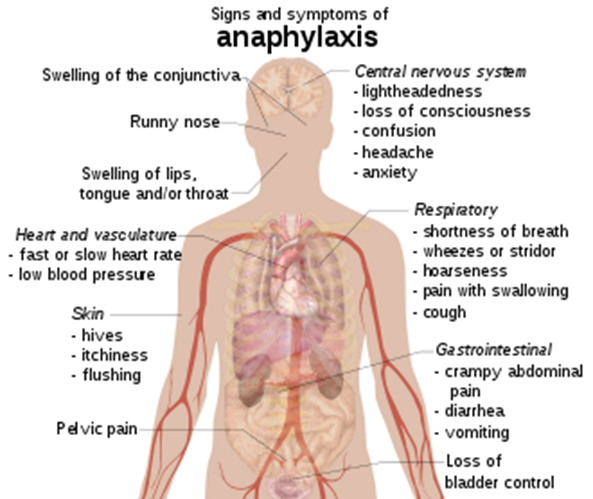A nurse is teaching a client about reducing the risk for osteoporosis. Which of the following statements by the client indicates an understanding of possible anaphylaxis?
A feeling of swelling in the feet
Pain at the injection site
A sudden decrease in heart rate
A sharp decrease in blood pressure
The Correct Answer is D
A. A feeling of swelling in the feet: Swelling in the feet can be caused by various factors such as fluid retention, circulatory issues, or certain medical conditions like venous insufficiency. It is not a typical symptom of anaphylaxis, which usually involves more generalized symptoms such as hives, itching, swelling of the face or throat, difficulty breathing, and a drop in blood pressure.
B. Pain at the injection site: Pain at the injection site is a common side effect of receiving an injection or medication. It occurs due to tissue irritation or trauma from the needle. While allergic reactions can cause localized redness, swelling, or itching at the injection site, severe pain alone is not a hallmark symptom of anaphylaxis.
C. A sudden decrease in heart rate: Anaphylaxis typically leads to an increase in heart rate (tachycardia) rather than a decrease. This increase in heart rate is a response to the body's attempt to compensate for the drop in blood pressure caused by anaphylaxis. Bradycardia (a decrease in heart rate) is not a typical feature of anaphylaxis unless it occurs very late in a severe reaction due to profound circulatory collapse.
D. A sharp decrease in blood pressure: This choice is indicative of an understanding of possible anaphylaxis. Anaphylaxis can cause a rapid and severe drop in blood pressure, known as hypotension. This drop in blood pressure is often a key feature of anaphylaxis and can lead to symptoms such as dizziness, fainting, confusion, and shock.

Nursing Test Bank
Naxlex Comprehensive Predictor Exams
Related Questions
Correct Answer is A
Explanation
A. Assault.
Assault is the threat or apprehension of harmful or offensive contact. In this scenario, the nurse is making a threat to administer medication by injection if the client doesn't comply with swallowing pills. Even though the nurse hasn't physically carried out the action yet, the threat itself constitutes assault. The client feels threatened by the nurse's statement, creating apprehension of harm or offensive contact.
B. Defamation: Defamation involves making false statements that harm a person's reputation. There is no indication of defamation in this scenario.
C. Battery: Battery involves the intentional and unauthorized touching of another person. While administering medication by injection without consent could be considered battery, the nurse has only made a threat at this point, not carried out the action.
D. Invasion of privacy: Invasion of privacy involves intruding into someone's private affairs without permission. There is no indication of invasion of privacy in this scenario.
Correct Answer is B
Explanation
A. Social worker:
While social workers play a vital role in addressing psychosocial needs and connecting clients with community resources, they typically do not have the specialized skills or training to address the physical limitations associated with feeding difficulties due to rheumatoid arthritis. Therefore, a referral to a social worker may not directly address the client's need for assistance with feeding.
B. Occupational therapist
Occupational therapists specialize in helping individuals regain or maintain independence in performing activities of daily living (ADLs), including feeding oneself. In the case of a client with severe rheumatoid arthritis in her hands who is unable to feed herself, an occupational therapist can assess the client's abilities, provide interventions such as adaptive equipment or techniques to facilitate feeding, and offer strategies to improve hand function and joint mobility. They can also collaborate with the client and other members of the healthcare team to develop a customized plan of care to address the client's specific needs and goals related to feeding and self-care.
C. Physician assistant:
Physician assistants work closely with physicians to provide medical care and may be involved in diagnosing and managing various health conditions. However, they do not typically provide specialized rehabilitation services or interventions related to activities of daily living such as feeding. Therefore, a referral to a physician assistant may not address the client's specific need for occupational therapy services.
D. Physical therapist:
Physical therapists specialize in restoring mobility, strength, and function, primarily focusing on gross motor skills and movement patterns. While physical therapists may address certain aspects of hand function and mobility, they do not specialize in activities of daily living such as feeding. Therefore, a referral to a physical therapist may not directly address the client's need for assistance with feeding due to severe rheumatoid arthritis in her hands.
Whether you are a student looking to ace your exams or a practicing nurse seeking to enhance your expertise , our nursing education contents will empower you with the confidence and competence to make a difference in the lives of patients and become a respected leader in the healthcare field.
Visit Naxlex, invest in your future and unlock endless possibilities with our unparalleled nursing education contents today
Report Wrong Answer on the Current Question
Do you disagree with the answer? If yes, what is your expected answer? Explain.
Kindly be descriptive with the issue you are facing.
